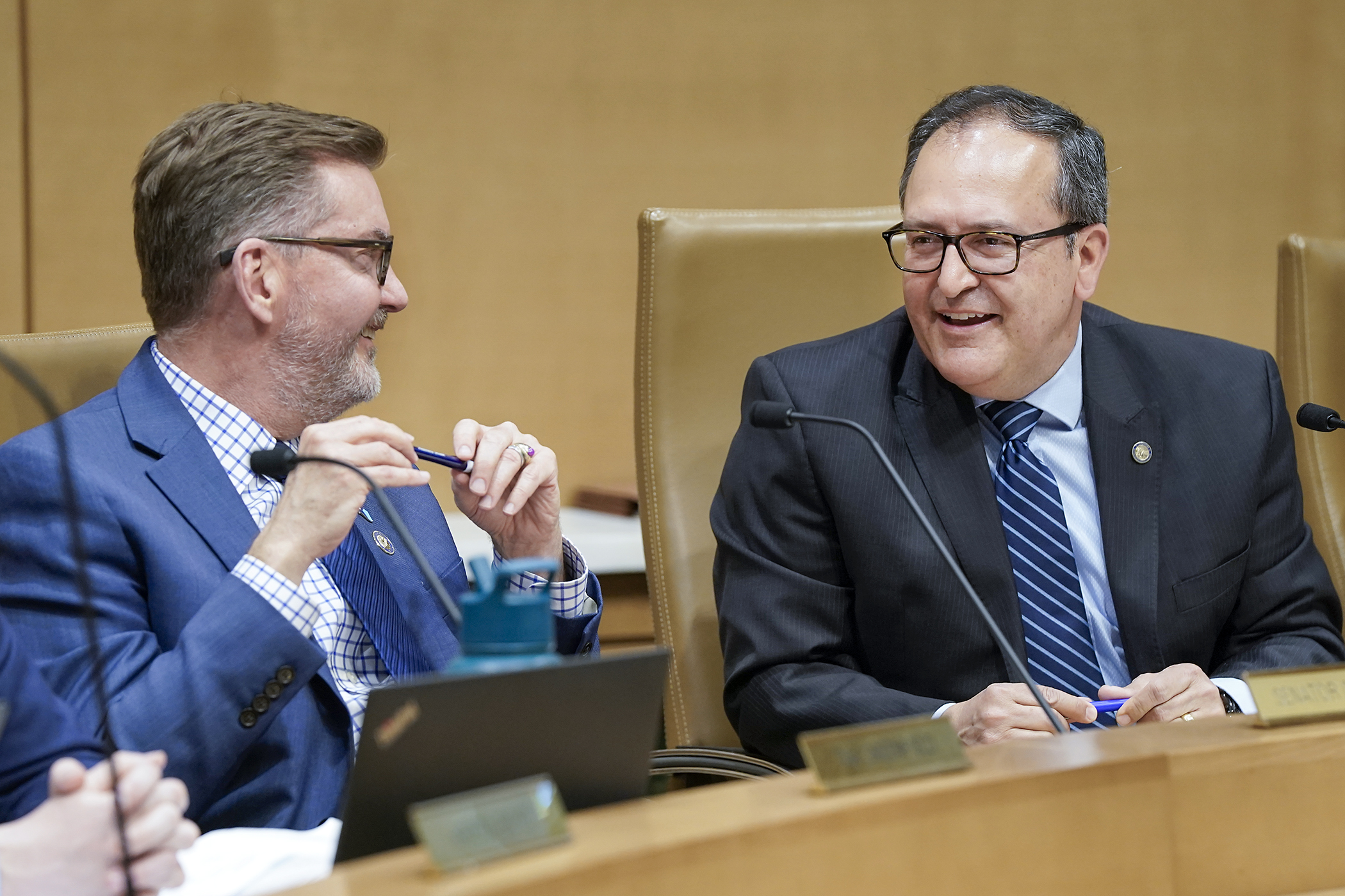Minnesota House, Senate revving up to bridge gaps in transportation bills

When it comes to transportation funding in the next biennium, the House is focusing more on specific large highway projects and less on public transit. Meanwhile, the Senate would like to see the State Patrol get up in the air and those on the ground think about another way to get to Duluth besides passenger rail.
Those are some of the big differences between the omnibus transportation bills that passed the House and Senate. A conference committee met for the first time on Thursday to reconcile the differences between the chambers’ two different versions of HF2438.
Co-chaired by Rep. Jon Koznick (R-Lakeville) and Sen. D. Scott Dibble (DFL-Mpls), the committee listened to nonpartisan staff walk through a summary and spreadsheet that covered the similarities and differences between the bills before hearing testimony from state agencies. They plan to meet again Friday to hear public testimony.
[MORE: View side-by-side comparisons of provisions, text and spreadsheets]
What’s the difference?
In looking at the largest increases above base funding, the House bill contains more than the Senate in the next biennium in the areas of:
- resilient pavement, $50 million;
- the I-35W and County State Aid Highway 50 interchange in Lakeville, $40.8 million;
- transportation economic development, $30 million;
- the Corridors of Commerce program, $20 million;
- local road wetland replacement, $10 million;
- a Duluth Airport air traffic control tower, $10 million; and
- the Trunk Highway 610 and East River Road interchange in Coon Rapids, $10 million.
As for the Senate bill, its appropriations are larger than what’s included in the House bill in the 2026-27 biennium in these areas:
- highway improvement for state road construction, $62 million;
- State Patrol aircraft purchase and staffing costs, $18.76 million;
- state roads operations and maintenance, $13.5 million;
- a long-term pavement performance program, $10 million; and
- highway debt service for a $100 million bond authorization, $9.25 million.
Here’s where the House bill would trim spending from the current base for fiscal 2026-27 more than the Senate bill would:
- Greater Minnesota transit, $12 million;
- Metropolitan Council transit system operations, $7.55 million;
- reducing a transfer to the Active Transportation Account, $4 million; and
- the Advisory Council on Traffic Safety, $3.25 million.
The largest of the Senate bill’s spending cuts would be in the cancellation of previous appropriations, all of which would apply to the current fiscal year. They include cutting $185.65 million from the Northern Lights Express rail project and $3.13 million from an analysis of St. Cloud transit service analysis.
Potential policy disputes
The House and Senate do agree on some things, such as extending previous appropriations related to the second daily train to and from Chicago (known as the Borealis), the I-94 land bridge project, and the Highways for Habitat program.
The two bodies also see eye to eye on extending the valid length of time for a commercial learner’s permit from six months to one year, and revising the list of documents that can be used to demonstrate a name change as part of the Real ID application.
But there are some policy issues on which the two bills diverge. For example, among the House-only policy items are:
- authorizing online driver’s license or Minnesota identification card renewal and duplicate issuance;
- broadening driver’s license revocation rules to include speeding convictions when exceeding the speed limit by 35 mph or more;
- directing the Department of Transportation to create a map-based portal for trunk highway projects and project analysis activity; and
- halting currently required assessments and mitigation activities governing greenhouse gas emissions for some trunk highway projects and delaying the requirements until Aug. 1, 2028, for projects subsequently added to the State Transportation Improvement Program.
As for the Senate, its bill would establish surcharges of $100 on plug-in hybrid electric vehicles, $40 for all-electric motorcycles and $20 for plug-in hybrid electric motorcycles. It would also amend the business liaison process for construction projects that produce substantial business impacts, establishing an economic assistance program for affected businesses.
The Senate would also revise the state’s jaywalking ordinances, commission a study on autonomous mower technology, and rename Minneapolis’ 10th Avenue Bridge the “Minnesota Senate Majority Leader Kari Dziedzic Memorial Bridge.”
Related Articles
Search Session Daily
Advanced Search OptionsPriority Dailies
Speaker Emerita Melissa Hortman, husband killed in attack
By HPIS Staff House Speaker Emerita Melissa Hortman (DFL-Brooklyn Park) and her husband, Mark, were fatally shot in their home early Saturday morning.
Gov. Tim Walz announced the news dur...
House Speaker Emerita Melissa Hortman (DFL-Brooklyn Park) and her husband, Mark, were fatally shot in their home early Saturday morning.
Gov. Tim Walz announced the news dur...
Lawmakers deliver budget bills to governor's desk in one-day special session
By Mike Cook About that talk of needing all 21 hours left in a legislative day to complete a special session?
House members were more than up to the challenge Monday. Beginning at 10 a.m...
About that talk of needing all 21 hours left in a legislative day to complete a special session?
House members were more than up to the challenge Monday. Beginning at 10 a.m...